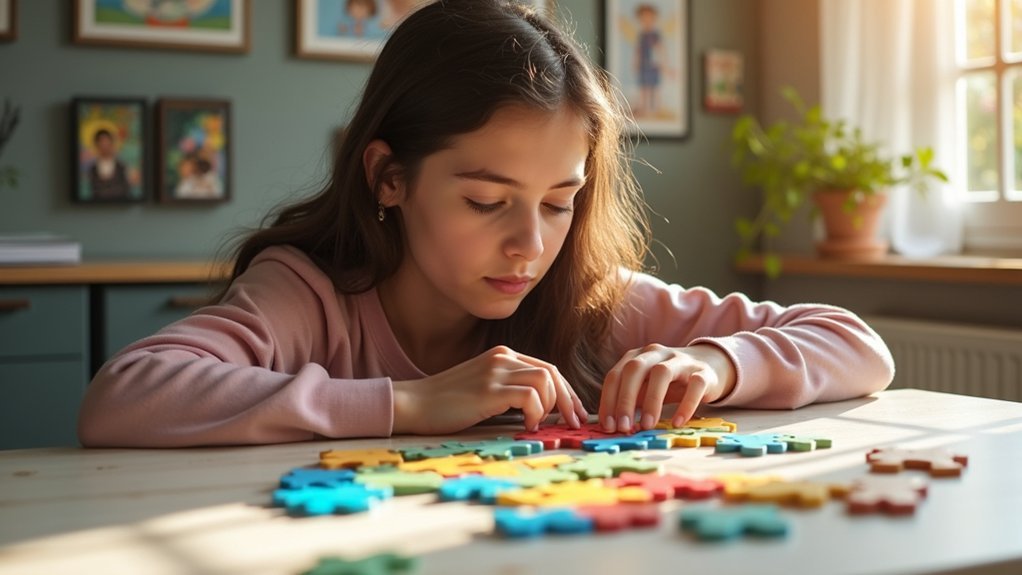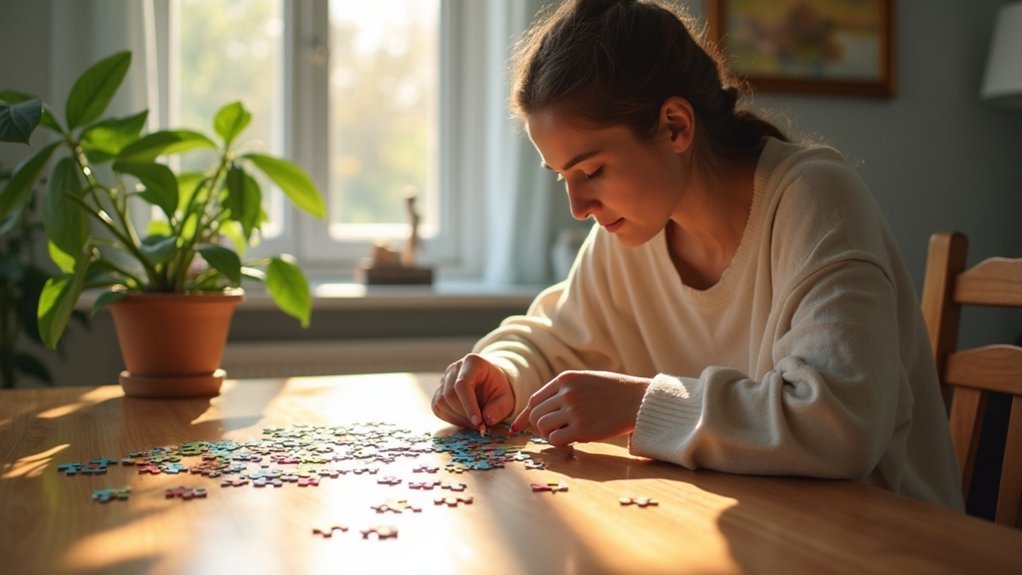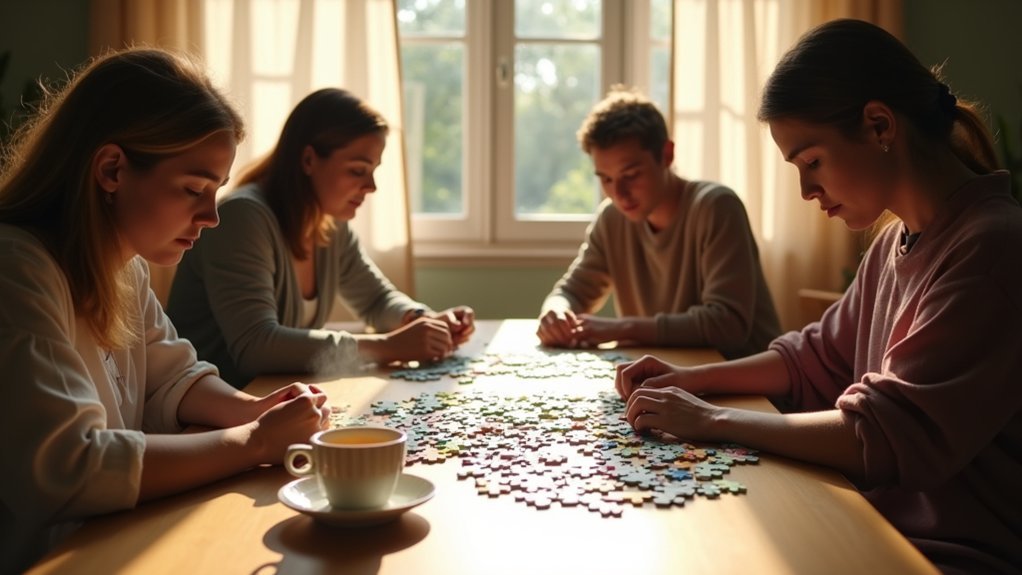Cognitive puzzles boost PTSD recovery by rewiring your brain’s neural pathways through neuroplasticity. Games like Tetris compete for the same visual processing resources that maintain flashbacks, disrupting traumatic memory consolidation. Regular puzzle engagement increases hippocampal volume—counteracting PTSD-related shrinkage—while strengthening cognitive flexibility and emotional regulation. You’ll experience fewer intrusive thoughts as puzzles activate your prefrontal cortex while reducing amygdala activity. Discover how different puzzle types can be tailored to your specific recovery journey.
Understanding Cognitive Flexibility in PTSD Patients

When examining PTSD recovery mechanisms, cognitive flexibility emerges as a vital factor that greatly influences symptom severity and treatment outcomes.
As a PTSD patient, your ability to switch between mental tasks and adapt to new information may be impaired, directly affecting your symptoms.
Research shows that your cognitive flexibility levels shortly after trauma can predict your future symptom severity. Higher flexibility correlates with fewer and less severe symptoms over time. This makes it a first line of defense against current PTSD symptoms. The Cognitive Flexibility Scale (CFS) used in clinical settings measures your communication effectiveness in new situations and has demonstrated reliable internal consistency.
Unlike regulatory flexibility (which helps with adaptive coping strategies), cognitive flexibility specifically impacts your immediate symptom management.
Understanding this distinction is significant because targeted interventions to improve your cognitive flexibility have demonstrated positive effects on reducing PTSD symptoms and enhancing treatment outcomes.
The Neuroscience Behind Puzzle Therapy
When you engage with cognitive puzzles, your brain actively rewires itself by forming new neural pathways that counteract trauma-related circuitry.
This neuroplastic process helps reset the cognitive-emotional connections that maintain intrusive traumatic memories and heightened fear responses. Research suggests that cognitive flexibility may explain why some individuals develop PTSD while others do not when exposed to similar traumatic events.
Your hippocampus, often compromised in PTSD, can actually increase in volume through consistent puzzle engagement, strengthening your brain’s resilience against stress.
Brain Rewiring Mechanisms
The neural foundations of puzzle therapy reveal a profound capacity for brain reorganization following trauma. When you engage with cognitive puzzles, you’re actively promoting neuroplasticity—your brain’s ability to form new neural pathways that bypass damaged areas.
Visuospatial activities like Tetris specifically increase hippocampal volume, directly counteracting the hippocampal shrinkage often seen in PTSD patients. This process helps your brain manage cognitive load more efficiently while reducing intrusive memory vividness.
As you solve puzzles regularly, you’re creating cognitive interference that weakens traumatic memory intensity. This mechanism works by occupying the same visual processing resources that would otherwise maintain vivid trauma flashbacks.
Your brain fundamentally rewires itself, developing improved emotional regulation circuits and enhanced cognitive flexibility—crucial skills for adapting to post-trauma life. Given that vision occupies approximately 27% of the cerebral cortex, puzzle therapy strategically leverages this dominant sensory processing area to maximize therapeutic impact.
Cognitive-Emotional Reset
At the heart of puzzle therapy’s effectiveness lies a sophisticated cognitive-emotional reset mechanism that transforms neural functioning in PTSD patients. When you engage with puzzles, you’re activating prefrontal regions while simultaneously reducing amygdala activity, fundamentally rewiring your brain’s fear response system.
This neural realignment creates a temporary emotional respite where your brain can process traumatic memories without being overwhelmed. You’re fundamentally training your prefrontal cortex to reassert control over emotional regulation. Studies demonstrate that patients with PTSD typically exhibit hyperactivation in dACC during fear processing that puzzles may help regulate.
The cognitive load required by puzzles diverts attention from intrusive thoughts while strengthening neural pathways associated with problem-solving rather than threat-detection.
Over time, this cognitive-emotional reset becomes more efficient through neuroplasticity, allowing you to develop improved stress management capabilities and emotional awareness that extend beyond puzzle-solving sessions into everyday functioning.
How Tetris Rewires Traumatic Memories

Recent scientific research has revealed that playing Tetris might considerably disrupt the formation of traumatic memories in patients with PTSD.
When you engage with this visuospatial puzzle game, you’re actually competing for the same cognitive resources your brain uses to consolidate traumatic visual memories. The game’s demanding visual processing creates cognitive interference precisely when your brain is trying to store these difficult memories.
During memory consolidation, Tetris effectively interrupts this process by occupying your visual working memory. Studies conducted in emergency departments show you’ll experience fewer intrusive flashbacks after playing Tetris following trauma exposure. This intervention is most effective when administered within six hours of the traumatic incident.
Playing Tetris hijacks visual processing pathways, reducing flashbacks when played shortly after traumatic experiences.
This intervention works by targeting the hippocampus—a brain region essential for memory formation—potentially enhancing neuroplasticity and facilitating healthier memory reconsolidation as you tackle each falling block.
Comparing Visual and Verbal Puzzle Effectiveness
While Tetris shows promise in PTSD treatment through visual memory interference, comparing visual and verbal puzzle types reveals key distinctions in their therapeutic effectiveness.
Research demonstrates that visuospatial puzzles notably reduce flashbacks, while verbal puzzles like quiz games may actually increase intrusive memories.
This difference stems from how PTSD affects your cognitive processing. Your brain shows enhanced perceptual priming for trauma-related visual images, making visual flashbacks particularly distressing.
Visuospatial tasks compete directly with the brain’s visual processing resources that maintain these flashbacks. Meanwhile, verbal tasks engage different neural pathways that might inadvertently strengthen trauma memory consolidation.
Your PTSD symptoms also influence puzzle effectiveness – if you experience vivid visual flashbacks, visual puzzles like Tetris may offer more relief than word-based alternatives. The optimal time for intervention appears within a 6-hour window post-trauma when memories remain malleable and susceptible to interference.
Hippocampal Growth Through Cognitive Challenges

Engaging in cognitive puzzles can stimulate your brain’s hippocampus to grow larger, potentially reversing the volume reduction commonly seen in PTSD.
Your brain’s spatial memory abilities improve as hippocampal neurons form new connections through regular cognitive challenges that require mental navigation and problem-solving.
This growth mechanism relies on neurotrophic factors—proteins that support neuron survival and growth—which are released during complex cognitive tasks that demand your full attention and mental effort.
Veterans with chronic combat-related PTSD who demonstrate smaller hippocampi may benefit most from targeted cognitive interventions designed to promote neuroanatomical recovery.
Volume Increase Mechanisms
As scientists have discovered, the human brain possesses remarkable neuroplasticity, allowing the hippocampus to physically grow in response to cognitive challenges. When you engage with puzzles, you’re triggering gene expression changes that support hippocampal health.
These activities stimulate neural growth pathways that can reverse trauma-related volume reductions. The mechanisms are multifaceted: cognitive puzzles activate stress reduction pathways while simultaneously promoting neural connections needed for fear extinction. Social enrichment combined with cognitive puzzles can further enhance this effect, as environmental factors have been shown to improve neurogenesis and counteract damage.
MRI studies confirm that consistent cognitive training leads to measurable increases in hippocampal volume. This growth is particularly important because larger hippocampal volume correlates with better PTSD treatment outcomes, especially for those with significant re-experiencing symptoms.
Some medications like paroxetine can further enhance this process, providing a complementary approach to hippocampal regrowth when combined with cognitive challenges.
Spatial Memory Enhancement
Spatial memory deficits represent a core challenge for PTSD patients, directly linked to the hippocampal volume changes we previously examined.
When you engage in cognitive puzzles that focus on navigation and spatial reasoning, you’re actively promoting dendritic complexity and synaptic density in your hippocampus—even without increasing its overall volume.
These puzzles strengthen your ability to process experiences from different perspectives (allocentric processing), which is essential for contextualizing traumatic memories.
By practicing viewpoint-independent spatial tasks, you’re enhancing neuronal circuitry that helps integrate traumatic experiences into memory systems more effectively.
The benefits extend beyond memory—spatial training shifts your brain away from habit-based memory systems toward more flexible hippocampal processing.
This aligns with research showing that SPS exposure in rat models led to slower acquisition in hippocampus-dependent place learning tasks, paralleling the spatial memory deficits seen in human PTSD.
This neuroplasticity directly contributes to reduced intrusive symptoms and improved overall PTSD management.
Emotional Regulation Benefits of Regular Puzzle Practice
While often viewed simply as entertainment, cognitive puzzles offer powerful therapeutic benefits for PTSD sufferers struggling with emotional regulation. When you engage with puzzles regularly, you’re strengthening neural circuits that manage emotional responses and reduce hypervigilance.
Your prefrontal cortex—the brain region responsible for emotion regulation—becomes more active during puzzle-solving, helping you gain better control over trauma-related distress. This cognitive engagement interrupts rumination cycles and lowers physiological arousal, giving you valuable emotional stability. The science shows that these activities can help restore function to a prefrontal cortex that has experienced reduced activity due to trauma exposure.
As you practice puzzles consistently, you’ll develop greater cognitive flexibility, enabling you to shift attention away from trauma triggers and adopt alternative thought patterns. This improved flexibility helps break rigid fear responses while facilitating the integration of trauma memories with less emotional reactivity.
Creating a Personalized Puzzle Recovery Plan

Creating an effective puzzle-based recovery strategy for PTSD requires careful personalization rather than a one-size-fits-all approach. Your unique trauma history, cognitive strengths, and therapeutic needs should shape your puzzle plan.
When developing your strategy, consider these key elements:
- Match puzzle types to your trauma – Visuospatial puzzles like Tetris may help with visual flashbacks, while word games might better address verbal rumination.
- Consider timing and frequency – Schedule puzzle sessions strategically around trigger exposure or memory reactivation.
- Integrate with existing therapy – Work with your therapist to complement traditional approaches like cognitive-behavioral therapy (CBT) and EMDR therapy, which are among the most established treatments for PTSD.
- Start simple and adjust – Begin with accessible puzzles that engage without overwhelming, then modify based on your response.
Remember that puzzle effectiveness varies; what works for others may not work for you.
Measuring Progress: Tracking Cognitive Improvements
Progress measurement forms the cornerstone of any effective PTSD recovery program involving cognitive puzzles. You’ll need both standardized tools and puzzle-specific metrics to accurately track your cognitive healing journey.
Use validated instruments like the PCL-5 or TOP-8 to establish your baseline and monitor symptom reduction. A 10-point decrease on the PCL-5 indicates clinically meaningful improvement. Clinicians might also employ the CAPS-5 structured interview to comprehensively assess changes in your PTSD symptom severity throughout treatment.
Track your performance on puzzles themselves—measuring completion time, accuracy, and difficulty progression provides concrete evidence of cognitive enhancement.
These measurements help you identify which cognitive domains (attention, memory, problem-solving) are improving and which need additional focus.
Integrating Puzzles With Traditional PTSD Treatments

Modern approaches to PTSD treatment now recognize the powerful synergy between traditional therapies and cognitive puzzles. When you combine evidence-based treatments like Cognitive Behavioral Therapy (CBT) or Prolonged Exposure with structured puzzle activities, you’re addressing PTSD from multiple angles.
Today’s PTSD care harnesses the powerful combination of clinical therapy and cognitive puzzles to create multidimensional healing pathways.
This integrated approach offers several key benefits:
- Enhanced Treatment Outcomes – Puzzles can boost cognitive flexibility while CBT tackles thought patterns, creating a more thorough recovery path.
- Memory Reconsolidation Support – Puzzle engagement may interfere with traumatic memory reconsolidation, reducing flashback intensity.
- Personalized Therapeutic Options – Your treatment plan can be tailored with specific puzzles that complement your primary therapy.
- Co-occurring Condition Relief – The combined approach helps manage depression, anxiety, and mood instability that often accompany PTSD.
Frequently Asked Questions
Can Puzzles Trigger Traumatic Memories During PTSD Recovery?
Yes, puzzles can trigger traumatic memories during PTSD recovery. If puzzle content resembles your trauma, it may activate your amygdala and reawaken distressing memories, especially if you’ve recently discussed traumatic events.
How Long Must Puzzle Therapy Continue to Maintain Recovery Benefits?
You’ll need ongoing puzzle therapy to maintain benefits, but there’s no definitive timeframe. Research suggests 6-14 weeks initially, with continued practice likely necessary for long-term PTSD symptom management, similar to traditional therapies.
Are Digital or Physical Puzzles More Effective for PTSD Symptoms?
Digital puzzles, especially Tetris, have stronger research support for PTSD symptom reduction. While physical puzzles offer environmental benefits, you’ll find digital options more scientifically validated for decreasing intrusive memories and improving hippocampal volume.
Can Puzzle Therapy Help With Treatment-Resistant PTSD?
Yes, puzzle therapy shows promise for your treatment-resistant PTSD. It can disrupt traumatic memories during reconsolidation, enhance cognitive flexibility, and serve as an effective adjunct to conventional therapies when other approaches haven’t worked well.
What Time of Day Is Optimal for Cognitive Puzzle Therapy?
You’ll benefit most from morning cognitive puzzle therapy when your alertness and cognitive flexibility peak. However, consistency matters more than timing—choose a time you can maintain regularly for ideal PTSD symptom reduction.
In Summary
You’ve now seen how puzzles can transform your PTSD recovery journey. By challenging your brain regularly, you’re rebuilding neural pathways, enhancing cognitive flexibility, and reclaiming control over traumatic memories. Don’t underestimate the power of these seemingly simple activities – they’re rewiring your brain in profound ways. Start small, be consistent, and watch as these cognitive challenges gradually strengthen your resilience against trauma’s grip.





Leave a Reply